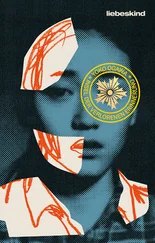The next coat has bloodstains. I wonder whether the patient suffered much—before I toss it in the cart.
“They used one on me when I was a kid,” I add. “A peanut went down the wrong tube and I couldn’t breathe. Nearly suffocated. It’s weird that one peanut could kill you.”
She doesn’t answer, so I go back to reading labels. The room smells like death and disinfectant.
The two of them have been doing it all over the hospital—in the wards, the labs, the broom closet. Maybe he’s even put the endoscope down her throat. Bet she looks as good inside as out—warm, red, inviting, all those little wrinkles tempting you deeper and deeper …
* * *
She knows exactly how she wants a job to be done. Twenty pages or fewer gets a paper clip; more than twenty, a binder clip. Sugar packets are for staff meetings; sugar cubes for guests. The surgery schedule is expected to be blown up 150 percent, and copies posted on the bulletin board (upper left-hand corner), on the side of the equipment locker, and on the door to the lounge. If a patient gives you cookies or other food, it goes on the middle shelf in the cupboard.
Not long after I started working here, some bigwig in Neurology asked us to help with a presentation he was going to give at a conference. It had all these graphs and charts, and he wanted it back in just two days. She split the work with me and we typed up labels for the slides.
“Use the number 508 stickers for the slides,” she told me. “They’re for conferences.” No. 508 was a dull gray.
I did the job just the way she had asked, but when the doctor returned to pick up the presentation, he took one look at it and threw it back on the desk. It all tumbled down onto the floor.
“This color won’t show up on the projector,” he said.
“I’m terribly sorry,” she said, stepping in before I had the chance to say anything. Her apology was really smooth. “I told her to use number 608 as usual, but it’s my fault for not checking. She’s new and I think she’s a little color-blind. I’m very sorry. We’ll get it redone by the end of the day.”
The doctor said he’d be back later and stormed out.
Color-blind? For a moment I wasn’t sure what she’d said—just that she’d sounded really charming when she’d said it. No. 608 was bright blue.
She had definitely told me no. 508. I knew because it was the same number as her apartment. I wasn’t likely to make a mistake about something like that. And she had given the presentation one more pass before the doctor had come to get it. I started picking up the papers.
“It’s your mistake,” she said. “You fix it.”
I didn’t finish until way after midnight. I felt like I was sinking in some kind of gray swamp.
The next morning she handed the new slides to the doctor as if she’d done them herself. He seemed really embarrassed he’d made such a fuss and he asked her out to lunch to apologize. I was not invited.
I never said a word of what happened, not to anyone. I was willing to be color-blind if it would keep her perfect.
* * *
“I told you she got pregnant just when he was about to ask her for the divorce.” I shake the next coat and two cafeteria tickets fall out of the pocket: one for spaghetti with meatballs and one for a cream soda. “I bet she did it on purpose, part of her evil scheme.”
She isn’t looking at me, but she doesn’t seem to be writing in the register anymore either. She’s usually such a perfectionist, but she can get pretty sloppy if she’s thinking about her doctor.
“When I asked him if he’d even told her, he got defensive and came up with all these excuses: they’re worried about the boy getting into the right elementary school; his wife could go into premature labor; he’s got some experiment running at the lab and can’t be distracted; the train got stuck in the snow … a load of crap!”
She stops for a moment and I read the label on the next coat. She writes it down in the register—I think.
The coats are in a pretty sorry state, all wrinkled and stained. Blood, spit, urine, tears. You can tell by the color, and the smell. It’s amazing all the stuff that can ooze out of a body.
“‘One lie leads to another,’” I say. She should know.
“He finally showed up past ten last night. Dog-tired—from being stuck on the train for five hours, he said. But I was the one who was tired. Tired of waiting all that time, of running to the door at every little noise, watching the dinner I’d made get cold.”
She runs her hand through her hair and looks down again. Her skin is so white. Her shoulders are really beautiful. The pen rolls across the desk.
“Do you know what he told me? He said he’d ‘had a lot of time to think’ on the train. That he felt like ‘some invisible force’ was holding him back. That it ‘wasn’t the right time,’ and that was why it had snowed. He said he wanted me to be patient, to wait just a little longer. ‘Just a little longer…’ And then we screwed, just like we always do. That’s all we have left.”
I imagine her naked. The doctor’s fingers running over her skin, her hair, the wet places. I picture her tongue licking the edge of the blue envelope. Who wouldn’t want her?
“Gastrointestinal Med., two long. Ophthalmology, one short. Neurosurgery, one long. Pediatrics, four short.” I pick up the pace, trying to distract her, but she’s not paying attention anymore. The pen’s still on the desk.
“How could he be so cruel? How could he tell me to wait? No, I couldn’t wait any longer. Not one more day, not one more second.”
I take the register and begin checking in the coats myself, trying to be as neat as she is.
“That’s why I killed him,” she says. Her voice is low and cold.
I feel a scream rising out of me, but somehow I stop it, hold it back, and instead I calmly imagine the scene: the knife in her pretty hand; the blade slicing into him again and again; skin ripping, blood spurting. But she’s spotless. I pick up the next coat.
“Respiratory Medicine, one long.”
It’s his. I shake it and out falls a tongue. It’s still soft. Maybe even warm.
“Dr. Y from Respiratory Medicine. Dr. Y from Respiratory Medicine. Please contact the pharmacy immediately.”
The public address system had been repeating this announcement for some time. I wondered who Dr. Y was and where he could be, as I studied the hospital directory. Central Records, Electro-Shock Clinic, Conference Center, Endoscopy … It was all like a foreign language to me.
“Why do they keep paging this Dr. Y?” I asked the woman behind the information desk.
“No one’s seen him this morning,” she said. She seemed annoyed by my question, and I was sorry I had bothered her.
“Could you tell me where to find the cardiac ward,” I said, getting to my real question. I pronounced each word slowly and carefully, hoping to quiet the pounding of my heart.
“Take that elevator to the sixth floor.” She pointed past a crowd of people gathered in front of Admitting; I noticed her nail polish was chipped.
* * *
I am a bag maker. For more than twenty years now I’ve kept a shop near the train station. It’s just a small place, but it has a nice display window facing the street. Inside, there are tables for the bags and a mirror, and a workshop in back, behind a curtain, with shelves for my materials. The window features a few purses, an ostrich handbag, and a suitcase. A jauntily posed mannequin clutches one of the purses, but her face is covered in a fine layer of dust because I haven’t changed the window in years.
I live on the second floor, above the shop. My apartment has just two rooms—an eat-in kitchen and a living room that doubles as my bedroom—but the place is bright and pleasant. On clear afternoons the sun streams in through the window and I have to move the hamster’s cage under the washstand. Hamsters don’t like direct sunlight.
Читать дальше












